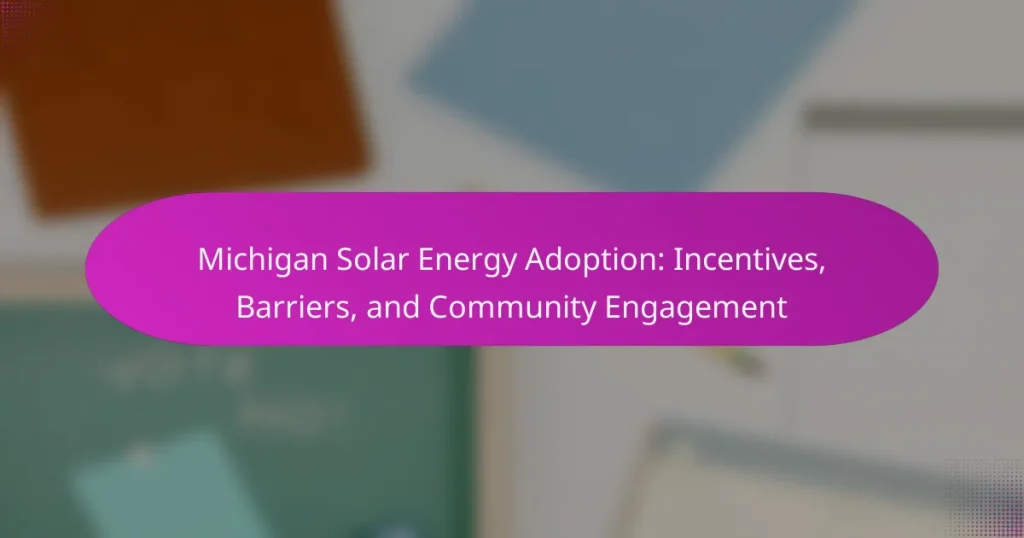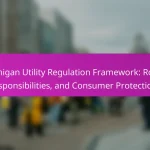
What is Michigan Solar Energy Adoption?
Michigan Solar Energy Adoption refers to the process of integrating solar energy systems into the state’s energy infrastructure. This involves residential, commercial, and utility-scale solar installations. As of 2023, Michigan has seen a significant increase in solar capacity, reaching over 2,000 megawatts. The state offers various incentives, such as tax credits and rebates, to encourage solar adoption. However, barriers like regulatory challenges and initial costs still exist. Community engagement initiatives aim to educate residents about solar benefits. Overall, Michigan’s solar energy adoption reflects a growing commitment to renewable energy sources.
How has solar energy adoption evolved in Michigan?
Solar energy adoption in Michigan has significantly increased over the past decade. In 2010, Michigan had less than 10 megawatts of installed solar capacity. By 2020, this figure rose to over 200 megawatts, reflecting a growing interest in renewable energy. State policies, such as the Renewable Portfolio Standard, have incentivized solar development. Additionally, various federal tax credits have supported residential solar installations. Community solar projects have also emerged, allowing broader access to solar energy. These initiatives have contributed to a more favorable environment for solar adoption. As of 2023, Michigan ranks among the top states for solar job growth. This trend indicates a strong commitment to expanding renewable energy resources in the state.
What historical factors have influenced solar energy growth in Michigan?
Solar energy growth in Michigan has been influenced by several historical factors. The 1970s energy crisis heightened awareness of alternative energy sources. This led to early state policies promoting renewable energy, including solar. In 2008, Michigan established the Renewable Portfolio Standard, mandating utilities to source a portion of energy from renewables. Federal incentives, such as the Investment Tax Credit, have also played a crucial role. The rise of local solar companies has contributed to increased adoption. Community engagement initiatives have further supported awareness and acceptance of solar energy. These historical developments have collectively shaped Michigan’s solar energy landscape.
What current trends are shaping solar energy adoption in the state?
In Michigan, current trends shaping solar energy adoption include increasing state incentives and community engagement. The state has introduced tax credits and rebates to encourage residential solar installations. Additionally, community solar projects are gaining popularity, allowing shared access to solar energy. The declining cost of solar technology is also a significant factor. According to the Solar Energy Industries Association, the cost of solar panels has dropped by about 70% since 2010. Furthermore, public awareness campaigns are educating residents about the benefits of solar energy. These trends collectively enhance solar adoption across Michigan.
What are the key incentives for adopting solar energy in Michigan?
Key incentives for adopting solar energy in Michigan include financial rebates, tax credits, and net metering policies. The Michigan Public Service Commission offers programs that provide financial assistance for solar installations. The federal solar investment tax credit allows homeowners to deduct a percentage of the installation costs from their federal taxes. Additionally, net metering allows solar system owners to receive credits for excess energy produced and sent back to the grid. These incentives reduce the overall cost of solar energy systems and encourage more residents to invest in renewable energy. According to the Michigan Energy Office, these incentives have significantly increased solar adoption throughout the state.
Which financial incentives are available for homeowners and businesses?
Homeowners and businesses in Michigan can access various financial incentives for solar energy adoption. These incentives include the federal solar investment tax credit (ITC), which allows a 26% tax credit on solar system costs. Additionally, Michigan offers a property tax exemption for solar energy systems, ensuring that the added value of the system does not increase property taxes. Utility companies may provide rebates for solar installations, further reducing upfront costs. Some local governments also have programs that offer low-interest loans for renewable energy projects. These financial incentives collectively encourage solar energy adoption by lowering initial investment barriers for homeowners and businesses.
How do state and federal tax credits impact solar energy investment?
State and federal tax credits significantly enhance solar energy investment. These financial incentives lower the upfront costs for consumers and businesses considering solar installations. For instance, the federal Investment Tax Credit (ITC) allows a deduction of up to 26% of the installation costs from federal taxes. This makes solar projects more financially viable. State-level incentives vary but often include additional tax credits or rebates. In Michigan, the state offers programs that complement federal credits. Research indicates that these incentives can lead to a substantial increase in solar adoption rates. According to the Solar Energy Industries Association, states with robust tax incentives see higher per capita solar installations. Thus, tax credits play a crucial role in driving solar energy investment.
What barriers exist to solar energy adoption in Michigan?
Barriers to solar energy adoption in Michigan include high upfront costs, regulatory challenges, and limited access to financing. The initial investment for solar systems can be prohibitive for many homeowners. Additionally, complex permitting processes can delay installations and deter potential adopters. Michigan’s net metering policies may not be as favorable compared to other states, impacting financial incentives. Furthermore, a lack of awareness and understanding about solar technology contributes to hesitancy among consumers. Local utility company policies may also create obstacles for integrating solar energy into the grid. These factors collectively hinder the growth of solar energy adoption in the state.
What regulatory challenges hinder solar energy growth?
Regulatory challenges that hinder solar energy growth include inconsistent policies and complex permitting processes. In Michigan, local regulations can vary significantly, leading to confusion for developers. Interconnection standards may also be unclear, complicating the integration of solar systems with the grid. Additionally, net metering policies can change, affecting the financial viability of solar projects. These factors create uncertainty and can deter investment in solar energy. Studies show that streamlined regulations can enhance solar adoption, as evidenced by states with clearer guidelines experiencing faster growth.
How do financial constraints affect potential adopters?
Financial constraints significantly limit potential adopters of solar energy systems. Many individuals and families lack the upfront capital required for installation. The average cost of a residential solar system in Michigan ranges from $15,000 to $25,000. This high initial investment can deter interested parties from proceeding with adoption. Additionally, financial constraints can restrict access to financing options or incentives. Research indicates that households with lower income levels are less likely to adopt solar energy due to these financial barriers. According to a study by the National Renewable Energy Laboratory, financial limitations account for a substantial portion of the adoption gap among different income groups.

How does community engagement influence solar energy adoption?
Community engagement significantly influences solar energy adoption by fostering awareness and support. Engaged communities are more likely to understand the benefits of solar energy. This understanding leads to increased interest in solar installations. Research shows that community-led initiatives can enhance local acceptance of solar projects. For instance, a study by the National Renewable Energy Laboratory found that community engagement can increase solar adoption rates by up to 50%. Local events and educational programs help demystify solar technology. They also build trust between residents and solar providers. Overall, active participation cultivates a positive environment for solar energy growth.
What role do local communities play in promoting solar energy?
Local communities play a crucial role in promoting solar energy by fostering awareness and facilitating access. They organize educational programs to inform residents about solar benefits. Community initiatives often lead to collective purchasing programs, reducing costs for participants. Local governments can implement policies that support solar energy adoption, such as streamlined permitting processes. Grassroots movements can advocate for renewable energy incentives at the state level. According to a study published in the journal “Energy Policy,” community engagement significantly increases solar installation rates. Local networks also provide platforms for sharing success stories, motivating others to adopt solar solutions.
How can community programs enhance public awareness of solar benefits?
Community programs can enhance public awareness of solar benefits through education and outreach initiatives. These programs often host workshops to inform residents about solar technology and its advantages. They can also distribute informational materials that highlight financial savings and environmental impacts. Engaging local leaders and influencers helps to build trust and encourage participation. Collaborating with schools can introduce solar education to younger audiences, fostering long-term awareness. Additionally, community programs can organize solar tours showcasing local installations. According to the Solar Energy Industries Association, increased community engagement leads to a 20% rise in solar adoption rates.
What partnerships exist between local governments and solar companies?
Local governments in Michigan partner with solar companies to promote renewable energy initiatives. These partnerships often involve collaborative projects for solar installations on public buildings. Local governments may provide incentives such as tax breaks or grants to encourage solar adoption. Solar companies, in return, can offer expertise and resources for efficient project implementation. Programs like community solar initiatives allow residents to benefit from shared solar resources. Additionally, local governments may engage in educational campaigns with solar companies to raise public awareness. Such collaborations aim to enhance energy sustainability and reduce carbon footprints in communities.
What are successful examples of community-led solar initiatives in Michigan?
Successful examples of community-led solar initiatives in Michigan include the Solar United Neighbors program and the Ann Arbor Solar Co-op. The Solar United Neighbors program helps communities organize solar co-ops. These co-ops allow residents to pool resources for solar installations. The Ann Arbor Solar Co-op has successfully installed solar panels on multiple homes. This co-op has facilitated over 200 solar installations since its inception. Additionally, the community solar project in Grand Rapids allows residents to purchase shares in a larger solar array. This project provides access to solar energy for those unable to install panels on their properties. These initiatives demonstrate effective community engagement in advancing solar energy adoption in Michigan.
How have community solar projects impacted local energy usage?
Community solar projects have significantly increased local energy usage of renewable sources. They provide access to solar energy for residents who cannot install solar panels on their properties. This accessibility leads to a greater adoption of clean energy. In Michigan, community solar projects have contributed to a reported increase in renewable energy generation by approximately 20% in areas with such initiatives. Additionally, these projects often result in lower energy costs for participants, encouraging more households to engage with renewable energy. The Michigan Public Service Commission noted that community solar programs have expanded participation in solar energy, thereby enhancing local energy resilience and sustainability.
What lessons can be learned from successful community solar programs?
Successful community solar programs demonstrate the importance of collaboration and stakeholder engagement. Engaging local communities fosters trust and participation. Programs that include diverse stakeholders often achieve greater success. Effective communication about benefits and processes is crucial. Transparent operations lead to higher community buy-in. Financial models that reduce barriers to entry increase participation rates. Programs that prioritize equity ensure access for low-income households. Data from the National Renewable Energy Laboratory shows that inclusive programs can increase solar adoption by 30%.

What are the future prospects for solar energy adoption in Michigan?
The future prospects for solar energy adoption in Michigan are promising. Michigan’s solar capacity has increased significantly in recent years. As of 2023, the state has over 2,000 megawatts of installed solar capacity. This growth is supported by state incentives and federal tax credits. The Michigan Public Service Commission has set goals for renewable energy, aiming for 50% by 2030. Additionally, community solar programs are expanding access for residents. The cost of solar technology continues to decline, making it more accessible. Local governments are increasingly adopting solar-friendly policies. These factors indicate a positive trend for solar energy adoption in Michigan.
How might technological advancements affect solar energy in Michigan?
Technological advancements will enhance solar energy efficiency and affordability in Michigan. Innovations in solar panel technology, such as bifacial panels, increase energy capture. Improved energy storage solutions, like advanced lithium-ion batteries, allow for better energy management. Enhanced grid integration technologies enable smoother incorporation of solar energy into existing systems. Additionally, data analytics and smart grid technologies optimize energy distribution. Michigan’s solar capacity could increase significantly, supported by these advancements. According to the Solar Energy Industries Association, Michigan’s solar capacity reached 1,000 MW in 2022, demonstrating growth potential.
What innovations are emerging in solar technology?
Emerging innovations in solar technology include bifacial solar panels, which capture sunlight on both sides. These panels can increase energy generation by up to 30%. Another innovation is solar tracking systems, which adjust the panel’s angle to follow the sun. This can boost efficiency by 25% compared to fixed panels. Additionally, advancements in perovskite solar cells are promising. They offer higher efficiency rates and lower production costs than traditional silicon cells. Energy storage solutions are also evolving, with new battery technologies providing longer life and faster charging. These innovations are crucial for enhancing solar energy adoption in Michigan and beyond.
How will these innovations change the landscape of solar energy adoption?
Innovations in solar energy technology will significantly enhance solar energy adoption in Michigan. These advancements include improved efficiency in solar panels and reduced costs for installation. For example, new solar panel designs can achieve efficiencies exceeding 22%, compared to older models averaging around 15-18%. Additionally, innovations in energy storage, such as advanced lithium-ion batteries, allow for better energy management. These storage solutions can reduce reliance on the grid during peak hours. Furthermore, streamlined permitting processes and digital platforms facilitate easier access for homeowners. As a result, more residents are likely to invest in solar energy systems. According to a report by the U.S. Department of Energy, the cost of solar energy has dropped by over 70% since 2010. This trend suggests that innovations will continue to drive adoption rates upward in Michigan and beyond.
What strategies can individuals and communities adopt to enhance solar energy adoption?
Individuals and communities can enhance solar energy adoption by implementing educational initiatives and financial incentives. Educational programs can inform residents about solar technology benefits and installation processes. Workshops and seminars can address common misconceptions about solar energy. Financial incentives, such as tax credits and rebates, can lower the cost barrier for potential adopters. Community solar projects allow individuals to invest in shared solar installations, increasing access for those who cannot install panels on their property. Local governments can streamline permitting processes to make installations easier. Collaborations with solar companies can lead to bulk purchasing discounts for communities. Finally, advocacy for supportive policies can create a favorable regulatory environment for solar energy growth.
What best practices can homeowners follow when considering solar energy?
Homeowners should assess their energy needs and roof suitability before installing solar energy systems. Evaluating energy consumption helps determine the appropriate system size. Checking roof orientation and shading ensures maximum sunlight exposure. It is essential to research local solar incentives and rebates. These financial benefits can significantly reduce installation costs. Homeowners should obtain multiple quotes from reputable installers. Comparing prices and services aids in making informed decisions. Understanding the warranty and maintenance requirements is crucial. This knowledge ensures long-term system performance. Engaging with local solar communities can provide valuable insights and support. Networking with others can enhance the solar adoption experience.
How can communities effectively advocate for solar energy policies?
Communities can effectively advocate for solar energy policies by organizing grassroots campaigns. These campaigns can raise awareness about solar benefits and engage local residents. Collaboration with local governments enhances credibility and influence. Building coalitions with environmental groups amplifies the advocacy efforts. Hosting informational workshops educates the public on solar energy. Collecting data on potential solar savings strengthens the case for policy change. Engaging with policymakers through meetings can directly influence decision-making. Communities should also utilize social media to broaden their reach and support.
Michigan Solar Energy Adoption is the integration of solar energy systems into the state’s energy infrastructure, encompassing residential, commercial, and utility-scale installations. The article examines the significant growth in Michigan’s solar capacity, which surpassed 2,000 megawatts by 2023, driven by state and federal incentives, community engagement, and technological advancements. It also highlights the barriers to adoption, such as high upfront costs and regulatory challenges, and discusses the role of local communities in promoting solar energy through educational initiatives and collaborative projects. Key financial incentives, including tax credits and rebates, are presented as crucial factors that encourage investment in solar energy systems.


